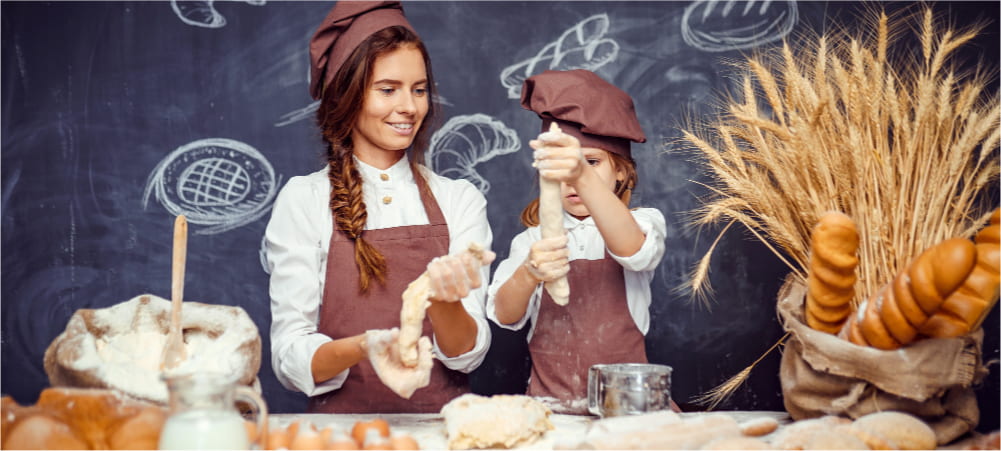Blog
Mastering the Art of Baking: Tips for Success
Baking is both an art and a science, and mastering it can be incredibly rewarding. Whether you’re preparing a simple loaf of bread or an intricate cake, the key to success lies in understanding the fundamentals and honing your skills over time. In this article, we’ll share essential tips and techniques that will help you become a better baker, whether you’re a beginner or looking to elevate your baking game.
1. Understand the Ingredients
One of the most important steps in mastering baking is understanding the ingredients you use. Baking relies heavily on the chemistry of ingredients interacting with each other. Here’s a breakdown of the most common baking ingredients and their roles:
a. Flour
Flour provides structure to baked goods. Different types of flour have varying protein content, which affects the texture of your baked goods. For example, all-purpose flour is versatile, while cake flour has less protein and produces a lighter texture. Bread flour, on the other hand, contains more gluten, making it perfect for bread-making.
b. Sugar
Sugar adds sweetness, but it also plays a crucial role in texture and browning. Brown sugar contains molasses, which adds moisture and depth of flavor, while granulated sugar creates a crisp texture. Sugar also helps retain moisture, which is essential in cakes and cookies.
c. Butter and Fats
Butter not only adds flavor but also creates a tender texture. The fat in butter coats the flour particles, preventing them from forming too much gluten, which results in a softer crumb. Oils and shortening also contribute to moisture, with oils being more versatile for vegan recipes.
d. Eggs
Eggs are multifunctional in baking. They help bind ingredients together, provide moisture, and act as leavening agents when beaten. The yolks also contribute richness, while the egg whites add structure when whipped.
e. Leavening Agents
Leavening agents, such as baking powder, baking soda, and yeast, help your baked goods rise. Baking soda and baking powder are chemical leaveners, while yeast is a living organism that ferments and releases gases that cause dough to rise. Understanding the difference between these agents is essential to achieving the desired texture.
f. Salt
Salt is often overlooked, but it’s essential in baking. It enhances flavors, balances sweetness, and controls yeast fermentation in bread. It also strengthens the dough and helps with browning.

2. Measure Ingredients Accurately
Baking is a precise science, and the accuracy of your measurements can make or break your recipe. Too much flour can result in a dense, dry texture, while too little sugar can make a cake fall flat. Here are a few tips for accurate measurements:
a. Use the Right Tools
Invest in high-quality measuring cups and spoons. For dry ingredients, use dry measuring cups (typically made of plastic or metal) and level off the top with a straight edge. For liquids, use liquid measuring cups with a spout and check the level at eye level.
b. Weigh Ingredients
For even more precision, especially with flour and butter, consider using a kitchen scale. Weighing ingredients ensures accuracy, and many professional bakers prefer this method because it eliminates inconsistencies from measuring cups and spoons.
c. Spoon and Level for Dry Ingredients
When measuring flour, always spoon the flour into your measuring cup and level it off with a flat edge. Scooping directly from the flour bag can compact the flour, leading to inaccurate measurements and heavy baked goods.
3. Temperature Matters
Temperature plays a significant role in the success of your baking. Here are some critical temperature-related tips:
a. Use Room Temperature Ingredients
Unless specified otherwise in the recipe, make sure your ingredients, such as butter, eggs, and milk, are at room temperature. This ensures they mix more easily and evenly, helping to create a smoother batter or dough.
b. Oven Temperature
Always preheat your oven before baking. A cold oven can result in uneven baking, affecting the rise and texture of your baked goods. Invest in an oven thermometer, as oven temperatures can often be inaccurate, which can lead to under- or overcooked treats.
c. Dough Temperature
When working with dough, especially yeast dough, make sure the ingredients are at the right temperature. Warm water (around 110°F) helps activate yeast, but water that’s too hot can kill the yeast. Always follow temperature instructions carefully when dealing with yeast-based recipes.
4. Practice Proper Mixing Techniques
How you mix your ingredients can impact the texture of your baked goods. Over-mixing or under-mixing can cause undesirable results. Here’s how to get it right:
a. Mixing Dry and Wet Ingredients Separately
For most baking recipes, it’s essential to mix dry ingredients (flour, sugar, leavening agents, etc.) and wet ingredients (eggs, milk, butter) separately before combining them. This ensures that the leavening agents are evenly distributed throughout the dry ingredients and helps prevent over-mixing when combining.
b. Don’t Overwork the Dough
When making bread, pie crust, or biscuits, overworking the dough can lead to tough, dense results. Mix until the dough just comes together, and avoid kneading too aggressively. For cakes and cookies, use a gentle hand to avoid over-developing the gluten, which can make the texture chewy rather than light.
c. Folding in Ingredients
When adding ingredients like whipped cream, egg whites, or fruit to your batter, use a gentle folding technique. This method prevents deflating the mixture and maintains the lightness and airiness of your baked goods.
5. Don’t Skip the Cooling Process
Once your baked goods are out of the oven, patience is key. Cooling is an essential part of baking that can affect texture, flavor, and ease of serving.
a. Cool on a Rack
After baking, allow your cakes, cookies, or breads to cool on a wire rack. This helps air circulate around the baked goods, preventing sogginess on the bottom. If you leave them in the pan too long, moisture can accumulate, affecting the texture.
b. Let Cakes and Breads Set
For cakes and breads, allow them to cool completely before slicing. Cutting into them too early can cause them to crumble or be too soft. Cakes, in particular, can continue to set as they cool, ensuring a firm texture once cut.
6. Experiment and Learn from Mistakes
Baking is a skill that improves with practice. While it’s important to follow recipes, don’t be afraid to experiment and make adjustments based on your preferences and the results you see. If a cake sinks in the middle, it might have been underbaked, or perhaps you opened the oven door too early. If your cookies are too flat, you might need to chill the dough before baking.
The key is to learn from each experience. Take notes on what works and what doesn’t, and use that knowledge to refine your technique.
7. Don’t Be Afraid to Try New Recipes
The best way to improve your baking skills is to try new recipes and challenge yourself with more complex techniques. Whether it’s making macarons for the first time or perfecting the art of sourdough bread, embracing new challenges will help you expand your baking repertoire and give you a deeper understanding of the craft.
Conclusion
Mastering the art of baking takes time, practice, and a little patience, but the rewards are well worth the effort. By understanding the roles of different ingredients, measuring accurately, paying attention to temperature, and practicing proper techniques, you’ll be well on your way to creating delicious baked goods every time. Whether you’re baking for a special occasion or just for fun, these tips will help you elevate your baking game and achieve better results with each attempt. So get in the kitchen, roll up your sleeves, and start baking your way to success!



